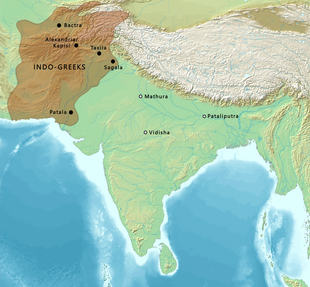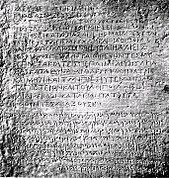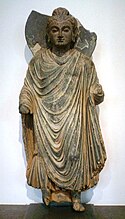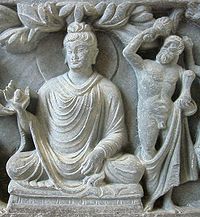Greco-Buddhism
| Part of a series on |
| Buddhism |
|---|
 |
Greco-Buddhism or Graeco-Buddhism denotes a supposed cultural syncretism between Hellenistic culture and Buddhism developed between the 4th century BC and the 5th century AD in Gandhara, in present-day Pakistan and parts of north-east Afghanistan.[2][3][4] While the Greco-Buddhist art shows clear Hellenistic influences, the majority of scholars do not assume a noticeable Greek influence on Gandharan Buddhism beyond the artistic realm.[5][6][7][8][9][10]
Cultural interactions between ancient Greece and Buddhism date back to Greek forays into the
Following the collapse of the Mauryan Empire, Buddhism continued to flourish under the
Historical outline
This section needs additional citations for verification. (February 2021) |

The introduction of
Thanks to relocation by the Persian Empire, there was established Greek culture in the far east of Alexander's empire. He founded several cities in his new territories in the areas of the
The
The Mauryan Emperor Ashoka established the largest Indian empire. Following the destructive Kalinga War, Ashoka converted to Buddhism. Abandoning an expansionist agenda, Ashoka would adopt humanitarian reformation in place.[15] As ascribed in the Edicts of Ashoka, the Emperor spread Dharma as Buddhism throughout his empire. Ashoka claims to have converted many, including the Greek populations within his realm to Buddhism:
Here in the king's domain among the Greeks, the Kambojas, the Nabhakas, the Nabhapamkits, the Bhojas, the Pitinikas, the Andhras, and the Palidas, everywhere people are following Beloved-of-the-Gods' instructions in Dharma.[16]
The decline and overthrow of the Mauryans by the
Cultural interaction
This section needs additional citations for verification. (February 2021) |
The length of the Greek presence in Central Asia and northern India provided opportunities for interaction, not only on the artistic but also on the religious plane.
Alexander the Great in Bactria and India (331–325 BC)
Silver. British Museum
When Alexander invaded
Mauryan Empire (322–183 BC)
The
Chandragupta's grandson Ashoka embraced the Buddhist faith and became a great proselytizer in the line of the traditional Pali canon of Theravada Buddhism, insisting on non-violence to humans and animals (ahimsa), and general precepts regulating the life of laypeople.
According to the
The conquest by
Pandyas, and as far as Tamraparni.[20]
Ashoka also claims he converted to Buddhism Greek populations within his realm:
Here in the king's domain among the Greeks, the Kambojas, the Nabhakas, the Nabhapamkits, the Bhojas, the Pitinikas, the Andhras and the Palidas, everywhere people are following Beloved-of-the-Gods' instructions in Dharma.[16]
Finally, some of the emissaries of Ashoka, such as the famous
Greek presence in Bactria (325–125 BC)
Alexander had established in Bactria several cities (such as Ai-Khanoum and Bagram) and an administration that were to last more than two centuries under the Seleucid Empire and the Greco-Bactrian Kingdom, all the time in direct contact with Indian territory. The Greeks sent ambassadors to the court of the Maurya Empire, such as the historian Megasthenes under Chandragupta Maurya, and later Deimachus under his son Bindusara, who reported extensively on the civilization of the Indians. Megasthenes sent detailed reports on Indian religions, which were circulated and quoted throughout the Classical world for centuries:[23]
Megasthenes makes a different division of the philosophers, saying that they are of two kinds, one of which he calls the
The Greco-Bactrians maintained a strong Hellenistic culture at the door of India during the rule of the Maurya Empire in India, as exemplified by the archaeological site of Ai-Khanoum. When the Maurya Empire was toppled by the Shunga Empire around 180 BC, the Greco-Bactrians expanded into India, where they established the Indo-Greek Kingdom, under which Buddhism was able to flourish.
Indo-Greek Kingdom and Buddhism (180 BC – 10 AD)
Coinage
The coins of the Indo-Greek king
Some of the coins of Menander I and Menander II incorporate the Buddhist symbol of the eight-spoked wheel, associated with the Greek symbols of victory, either the palm of victory, or the victory wreath handed over by the goddess Nike. According to the Milinda Pañha, at the end of his reign Menander I became a Buddhist arhat,[27] a fact also echoed by Plutarch, who explains that his relics were shared and enshrined.[28]
The ubiquitous symbol of the elephant in Indo-Greek coinage may also have been associated with Buddhism, as suggested by the parallel between coins of Antialcidas and Menander II, where the elephant in the coins of Antialcidas holds the same relationship to Zeus and Nike as the Buddhist wheel on the coins of Menander II. When the Zoroastrian Indo-Parthian Kingdom invaded North India in the 1st century AD, they adopted a large part of the symbolism of Indo-Greek coinage, but refrained from ever using the elephant, suggesting that its meaning was not merely geographical.

Finally, after the reign of Menander I, several Indo-Greek rulers, such as
Cities
According to
Scriptures
Evidence of direct religious interaction between Greek and Buddhist thought during the period include the
The
Several Buddhist dedications by Greeks in India are recorded, such as that of the Greek
Buddhist manuscripts in cursive Greek have been found in Afghanistan, praising various Buddhas and including mentions of the Mahayana figure of "Lokesvararaja Buddha" (λωγοασφαροραζοβοδδο). These manuscripts have been dated later than the 2nd century CE.[32]
Kushan empire (1st–3rd century AD)
The Kushan Empire, one of the five tribes of the Yuezhi, settled in Bactria around 125 BC, displacing the Greco-Bactrians and invading the northern parts of Pakistan and India from around 1 AD. By that time they had already been in contact with Greek culture and the Indo-Greek kingdoms for more than a century. They used the Greek script to write their language, as exemplified by their coins and their adoption of the Greek alphabet.

The Kushan King Kanishka, who honored Zoroastrian, Greek and Brahmanic deities as well as the Buddha and was famous for his religious syncretism, convened the
Philosophical influences
| Part of a series on |
Buddha in the Japanese Tea Garden, San Francisco |
|---|
Several Greek philosophers, including Pyrrho, Anaxarchus, and Onesicritus accompanied Alexander in his eastern campaigns. During the 18 months they were in India, they were able to interact with Indian philosophers who pursued asceticism, generally described as gymnosophists ("naked philosophers").[34]
Pyrrhonism
Pyrrho returned to Greece and founded
Pyrrho was directly influenced by Buddhism in developing his philosophy, which is based on Pyrrho's interpretation of the Buddhist three marks of existence.[35][37]
Cynicism
Another of these philosophers, Onesicritus, a Cynic, is said by Strabo to have learnt in India the following precepts: "That nothing that happens to a man is bad or good, opinions being merely dreams. ... That the best philosophy [is] that which liberates the mind from [both] pleasure and grief".[24] Cynicism, particularly the Cynic Peregrinus Proteus was further influenced by the tales of the gymnosophists, particularly the examples set by Kalanos, Dandamis, and Zarmanochegas.[citation needed]
Cyrenaicism
The Cyrenaic philosopher Hegesias of Cyrene, from the city of Cyrene where Magas of Cyrene ruled, is thought by some to have been influenced by the teachings of Ashoka's Buddhist missionaries.[38]
Artistic influences
This section needs additional citations for verification. (February 2021) |
Numerous works of
Anthropomorphic representation of the Buddha
Although there is still some debate, the first anthropomorphic representations of the Buddha himself are often considered a result of the Greco-Buddhist interaction. Before this innovation, Buddhist art was "aniconic": the Buddha was only represented through his symbols (an empty throne, the Bodhi Tree, Buddha footprints, the Dharmachakra).
This reluctance towards anthropomorphic representations of the Buddha, and the sophisticated development of aniconic symbols to avoid it (even in narrative scenes where other human figures would appear), seem to be connected to one of the Buddha's sayings reported in the
Probably not feeling bound by these restrictions, and because of "their cult of form, the Greeks were the first to attempt a sculptural representation of the Buddha".
Many of the stylistic elements in the representations of the Buddha point to Greek influence:
Greek artists were most probably the authors of these early representations of the Buddha, in particular the standing statues, which display "a realistic treatment of the folds and on some even a hint of modelled volume that characterizes the best Greek work. This is Classical or Hellenistic Greek, not archaizing Greek transmitted by Persia or Bactria, nor distinctively Roman."[43]
The Greek stylistic influence on the representation of the Buddha, through its idealistic realism, also permitted a very accessible, understandable and attractive visualization of the ultimate state of
One of the distinguishing features of the Gandharan school of art that emerged in north-west India is that it has been clearly influenced by the naturalism of the Classical Greek style. Thus, while these images still convey the inner peace that results from putting the Buddha's doctrine into practice, they also give us an impression of people who walked and talked, etc. and slept much as we do. I feel this is very important. These figures are inspiring because they do not only depict the goal, but also the sense that people like us can achieve it if we try.
During the following centuries, this anthropomorphic representation of the Buddha defined the canon of Buddhist art, but progressively evolved to incorporate more Indian and Asian elements.
Hellenized Buddhist pantheon
Several other Buddhist deities may have been influenced by Greek gods. For example, Heracles with a lion-skin, the protector deity of Demetrius I of Bactria, "served as an artistic model for Vajrapani, a protector of the Buddha".[45][46] In Japan, this expression further translated into the wrath-filled and muscular Niō guardian gods of the Buddha, standing today at the entrance of many Buddhist temples.
According to Katsumi Tanabe, professor at Chūō University, Japan, besides Vajrapani, Greek influence also appears in several other gods of the Mahayana pantheon such as the Japanese Fūjin, inspired from the Greek divinity Boreas through the Greco-Buddhist Wardo, or the mother deity Hariti inspired by Tyche.[47]
In addition, forms such as garland-bearing cherubs, vine scrolls, and such semihuman creatures as the centaur and triton, are part of the repertory of Hellenistic art introduced by Greco-Roman artists in the service of the Kushan court.
Exchanges
This section needs additional citations for verification. (February 2021) |
Proselytism in the East
Greek monks played a direct role in the upper hierarchy of Buddhism, and in its early dissemination. During the rule (165–135 BC) of the
Buddhist monks from the region of
"
Kyūshū, Japan). (...) In former times, the people of Fusang knew nothing of the Buddhist religion, but in the second year of Da Ming of the Song dynasty [AD 485], five monks from Kipin (Kabulregion of Gandhara) travelled by ship to Fusang. They propagated Buddhist doctrine, circulated scriptures and drawings, and advised the people to relinquish worldly attachments. As a result the customs of Fusang changed." (Chinese: "扶桑在大漢國東二萬餘里,地在中國之東(...)其俗舊無佛法,宋大明二年,罽賓國嘗有比丘五人游行至其國,流通佛法,經像,教令出家,風 俗遂改.")
Two half-brothers from
Greco-Buddhism in the West

Intense westward physical exchange at that time along the
Another century later the Christian
Indian gravestones from the
The pre-Christian monastic order of the
Buddhism and Christianity

Although the philosophical systems of Buddhism and Christianity have evolved in rather different ways, the moral precepts advocated by Buddhism from the time of Ashoka through his edicts do have some similarities with the Christian moral precepts developed more than two centuries later: respect for life, respect for the weak, rejection of violence, pardon to sinners, tolerance.
One theory is that these similarities may indicate the propagation of Buddhist ideals into the Western World, with the Greeks acting as intermediaries and religious syncretists.[58]
Scholars have often considered the possibility that Buddhism influenced the early development of Christianity. They have drawn attention to many parallels concerning the births, lives, doctrines, and deaths of the Buddha and Jesus.[citation needed]
— Bentley, Old World Encounters
Saint Jerome (4th century AD) mentions the birth of the Buddha, who he says "was born from the side of a virgin,"[59] and the influential early Christian church father Clement of Alexandria (d. 215) mentioned Buddha (Βούττα) in his Stromata (Bk I, Ch XV).[52] The legend of Christian saints Barlaam and Josaphat draws on the life of the Buddha.[60]
Reception
The idea of a Greek influence on the development of Buddhism has been particularly advocated by Étienne Lamotte[61] and Thomas McEvilley, who has speculated that “like the Gandharan art style, the Gandharan Buddhist style must have had a prominent Hellenic factor”,[62] although he does not employ the term "Greco-Buddhism" for this. McEvilley's theory has been met by skepticism by other scholars.[63][64][65]
While the Hellenistic influences in Gandharan Buddhist art have been widely accepted[42][66][67] it remains a matter of controversy among art historians whether the non-Indian characteristics of Gandhāran sculpture reflect a continuous Greek tradition rooted in Alexander’s conquests in Bactria, subsequent contacts with later traditions of the Hellenistic east, direct communication with contemporary artists from the Roman empire, or some complex conjunction of such sources.[68] Examples include statues of bodhisattvas adorned with royal jewellery (bracelets and torques) and amulet boxes, the contrapposto stance, an emphasis on draperies, and a plethora of Dionysian themes.[42]
Beyond the artistic realm, however, most scholars do not assume a noticeable Greek influence on Gandharan Buddhism.[5][6][7][8][9][10][69] Some have identified a need for further rearch in this regard.[3][70] Olga Kubica has criticised the term "Greco-Buddhism" as "inadequate" since a "reconciliation or union of differing systems of belief" did not occur here. She states that she does "not exclude the possibility that some phenomena within Buddhism may be interpreted as a manifestation of syncretism between Greek and Buddhist elements, but the term Greco-Buddhism applies only to certain aspects and not to the entirety of Greco-Buddhist relations".[2]
The term "Greco-Buddhist art" has also been criticised among art historians.[71][72] According to Peter Stewart, it is "deeply deceptive in several ways and should be avoided".[73] Johanna Hanink has attributed the concept of "Greco-Buddhist art" to a European scholarly inability to accept that natives could have developed "the pleasing proportions and elegant poses of sculptures from ancient Gandhara", citing Michael Falser and arguing that the entire notion of "Buddhist art with a Greek 'essence'" is a colonial imposition that originated during British rule in India.[74][75]
See also
- Gandharan Buddhism
- Gandhāran Buddhist texts
- Greco-Bactrian Kingdom
- Greco-Buddhist Art
- Greco-Buddhist monasticism
- Indo-Greek Kingdom
- Manicheanism
- Milinda Pañha
- Nāgasena
- Religions of the Indo-Greeks
- Silk road transmission of Buddhism
- Buddhism in Central Asia
- Buddhas of Bamyan
- Kushan Empire
- Ancient Greece–Ancient India relations
- Index of Buddhism-related articles
Notes
- ISBN 9780199340378. Archivedfrom the original on 19 February 2019. Retrieved 30 May 2021.
- ^ ISBN 978-1-032-19302-1.
- ^ ISBN 978-90-04-25528-9.
- ISBN 978-81-7835-722-5. Archivedfrom the original on 2023-01-15. Retrieved 2022-05-18.
- ^ ISBN 978-90-04-15830-6.
- ^ ISBN 978-1-61429-168-8.
- ^ ISBN 978-0-295-97769-0.
- ^ ISBN 978-2-85539-601-9.
- ^ ISBN 978-94-024-0851-5.
- ^ ISBN 978-94-024-0851-5.
- ISBN 0226742210. Archivedfrom the original on 2022-10-05. Retrieved 2022-05-11.
- ^ Davies, Cuthbert Collin (1959). An Historical Atlas of the Indian Peninsula. Oxford University Press.
- ISBN 0-89005-109-7.
- ISBN 3-14-100919-8.
- .
- ^ a b Rock Edict Nb13 (S. Dhammika)
- ^ Foltz, Religions of the Silk Road, p. 43
- ^ "The whole region from Phrygia to the Indus was subject to Seleucus. He crossed the Indus and waged war with Sandrocottus [Chandragupta], king of the Indians, who dwelt on the banks of that stream until they came to an understanding with each other and contracted a marriage relationship. Some of these exploits were performed before the death of Antigonus and some afterward." Appian History of Rome, The Syrian Wars 55 Archived 2015-10-20 at the Wayback Machine
- ISBN 978-90-04-25530-2.
- ^ Rock Edict Nb.13, Full text of the Edicts of Ashoka. See Rock Edict 13 Archived 2013-10-28 at the Wayback Machine
- ^ "Chapter XII". 20 October 2014. Archived from the original on 2014-10-20.
- ^ "Abstract Sujato: Sects & Sectarianism". www.congress-on-buddhist-women.org. Archived from the original on 2019-12-18. Retrieved 2015-12-25.
- ^ Surviving fragments of Megasthenes:Full text
- ^ a b Strabo, XV.I.65: "Strabo XV.1". Perseus.tufts.edu. Archived from the original on 2007-12-27. Retrieved 2010-09-01.
- ^ a b Strabo, xv, 1, on the immolation of the Sramana in Athens (Paragraph 73) Archived 2008-10-04 at the Wayback Machine.
- ^ .
- ^ Extract of the Milinda Panha: "And afterwards, taking delight in the wisdom of the Elder, he handed over his kingdom to his son, and abandoning the household life for the houseless state, grew great in insight, and himself attained to Arahatship!" (The Questions of King Milinda, Translation by T. W. Rhys Davids, 1890)
- ^ Plutarch on Menander: "But when one Menander, who had reigned graciously over the Bactrians, died afterwards in the camp, the cities indeed by common consent celebrated his funerals; but coming to a contest about his relics, they were difficultly at last brought to this agreement, that his ashes being distributed, everyone should carry away an equal share, and they should all erect monuments to him." (Plutarch, "Political Precepts" Praec. reip. ger. 28, 6) p147–148 Full text
- ^ Milinda Panha, Chap. I
- ISBN 978-1-58115-933-2.
- ISBN 978-1-108-00941-6. Archivedfrom the original on 15 January 2023. Retrieved 15 November 2015.
- ^ Nicholas Sims-Williams, "A Bactrian Buddhist Manuscript"
- ^ Foltz, Religions of the Silk Road, p. 45
- from the original on 2023-01-15. Retrieved 2021-02-14.
- ^ from the original on 2023-01-15. Retrieved 2021-02-13.
- ^ "He would withdraw from the world and live in solitude, rarely showing himself to his relatives; this is because he had heard an Indian reproach Anaxarchus, telling him that he would never be able to teach others what is good while he himself danced attendance on kings in their court. He would maintain the same composure at all times." (Diogenes Laertius, IX.63 on Pyrrhon)
- ISBN 9781400866328. Archived(PDF) from the original on 2016-11-30. Retrieved 2017-05-10.
- from the original on 2021-03-08. Retrieved 2020-04-14.
The philosopher Hegesias of Cyrene (nicknamed Peisithanatos, "The advocate of death") was a contemporary of Magas and was probably influenced by the teachings of the Buddhist missionaries to Cyrene and Alexandria. His influence was such that he was ultimately prohibited from teaching.
- ^ "Due to the statement of the Master in the Dighanikaya disfavouring his representation in human form after the extinction of body, reluctance prevailed for some time". Also "Hinayanis opposed image worship of the Master due to canonical restrictions". R.C. Sharma, in "The Art of Mathura, India", Tokyo National Museum 2002, p.11
- ^ Linssen; Robert (1958). Living Zen. London: Allen & Unwin. p. 206.
- ISBN 978-0-691-21747-5. Archivedfrom the original on 15 January 2023. Retrieved 12 December 2021.
- ^ ISBN 978-90-04-25528-9.
- ^ Boardman p. 126
- ^ 14th Dalai Lama, foreword to "Echoes of Alexander the Great", 2000.
- ISBN 9780230621251.
- ^ See Images of the Herakles-influenced Vajrapani: "Image 1". Archived from the original on December 16, 2013, "Image 2". Archived from the original on March 13, 2004.
- OCLC 937316326.
- ISBN 978-0-230-62125-1.
- ISBN 0-520-21972-4.
- ^ Soothill, William Edward; Hodous, Lewis (1995). A Dictionary of Chinese Buddhist Terms (PDF). London: RoutledgeCurzon. Archived from the original (PDF) on March 3, 2014.
- ^ Plutarch. "Life of Alexander". The Lives of the Noble Grecians and Romans. The Modern Library. Translated by Dryden, John; Clough, Arthur Hugh. New York: Random House. p. 850.
- ^ a b "Clement of Alexandria Stromata. BkI, Ch XV". Archived from the original on 22 October 2012. Retrieved 19 Dec 2012.
- ^ Tarn. The Greeks in Bactria and India. p. 370.
- ^ a b Linssen; Robert (1958). Living Zen. London: Allen & Unwin. p. 208.
- ^ According to the linguist Zacharias P. Thundy[full citation needed]
- ISBN 1-85230-835-4.
- ^ Ullrich R . Kleinhempel, "Traces of Buddhist Presence in Alexandria: Philo and the "Therapeutae"", Научно-теоретический журнал 2019 https://www.academia.edu/39841429/Traces_of_Buddhist_Presence_in_Alexandria_Philo_and_the_Therapeutae_ Archived 2021-01-21 at the Wayback Machine
- ^ Foltz. Religions of the Silk Road. p. 44.
Certain Indian notions may have made their way westward into the budding Christianity of the Mediterranean world through the channels of the Greek diaspora
- ^ McEvilley, p391
- ^ Walbridge, John (2001). The Wisdom of the Mystic East: Suhrawardī and Platonic Orientalism. p. 129.
The form Būdhīsaf is the original, as shown by Sogdian form Pwtysfi and the early New Persian form Bwdysf
On the Christian versions see A. S. Geden, Encyclopaedia of Religion and Ethics, s.v. "Josaphat, Barlaam and," and M. P. Alfaric, ..." - ISBN 978-90-6831-100-6.
- ISBN 978-1-58115-203-6.
- ISSN 0009-840X.
- ISSN 1022-4556.
- ISSN 1529-1898.
- ISBN 978-1-58115-203-6.
- ISBN 978-92-3-102846-5.
- ISBN 978-1-61429-168-8.
- ISBN 978-90-6984-256-1.
- ISSN 0012-8708.
- ISSN 0929-077X.
- ISBN 978-88-6969-577-3.
- ISBN 978-1-80327-694-6.
- ^ "Stop crediting the West for "inspiring" classical Chinese art". Quartz. Retrieved 18 February 2023.
- ^ Falser, M. (2015). The Graeco-Buddhist style of Gandhara-a 'Storia ideologica', or: how a discourse makes a global history of art. Journal of Art Historiography, (13), 1.
Bibliography
- Vassiliades, Demetrios Th. 2016. Greeks and Buddhism. Athens, Indo-Hellenic Society for Culture & Development ELINEPA.
- Alexander the Great: East-West Cultural Contacts from Greece to Japan. Tokyo: NHK Puromōshon and Tokyo National Museum, 2003.
- Baums, Stefan. 2012. “Catalog and Revised Texts and Translations of Gandharan Reliquary Inscriptions.” In: David Jongeward, Elizabeth Errington, Richard Salomon and Stefan Baums, Gandharan Buddhist Reliquaries, p. 204, Seattle: Early Buddhist Manuscripts Project (Gandharan Studies, Volume 1).
- Baums, Stefan, and Andrew Glass. 2002– . Catalog of Gāndhārī Texts, no. CKI 32 Archived 2018-08-21 at the Wayback Machine
- Jerry H. Bentley. Old World Encounters: Cross-cultural Contacts and Exchanges in Pre-modern Times. Oxford–NY: Oxford University Press, 1993. ISBN 0-19-507639-7
- John Boardman. The Diffusion of Classical Art in Antiquity. Princeton, NJ: Princeton University Press, 1994. ISBN 0-691-03680-2
- Shravasti Dhammika, trans. The Edicts of King Asoka: An English Rendering. Kandy, Sri Lanka: Buddhist Publication Society, 1993. ISBN 955-24-0104-6
- ISBN 978-0-230-62125-1
- Georgios T. Halkias, “When the Greeks Converted the Buddha: Asymmetrical Transfers of Knowledge in Indo-Greek Cultures”, in Trade and Religions: Religious Formation, Transformation and Cross-Cultural Exchange between East and West, ed. Volker Rabens. Leiden: Brill, 2013, p. 65–115.
- Kubica, Olga (2023). Greco-Buddhist relations in the Hellenistic Far East : sources and contexts. New York: Routledge. ISBN 9781003258575.
- Robert Linssen. Living Zen. NY: Grove Press, 1958. ISBN 0-8021-3136-0
- Lowenstein, Tom (1996). The vision of the Buddha. Duncan Baird Publishers. ISBN 1-903296-91-9.
- ISBN 1-58115-203-5
- William Woodthorpe Tarn. The Greeks in Bactria and India. Cambridge: Cambridge University Press, 1951, ISBN 81-215-0220-9
- Marian Wenzel. Echoes of Alexander the Great: Silk Route Portraits from Gandhara, foreword by the Dalai Lama. Eklisa Anstalt, 2000. ISBN 1-58886-014-0
- Paul Williams. Mahāyāna Buddhism: the Doctrinal Foundations. London–NY: Routledge, 1989. ISBN 0-415-02537-0
External links
- UNESCO: Threatened Greco-Buddhist art (archived 29 March 2002)
- Alexander the Great: East-West Cultural contacts from Greece to Japan (in Japanese) (archived 6 March 2012)
- The Hellenistic age (archived 4 February 2014)
- The Kanishka Buddhist coins (archived 17 August 2009)
- Interim period: Mathura as the Vaishnava-Buddhist seat of culture and learning (archived 10 September 2006)


